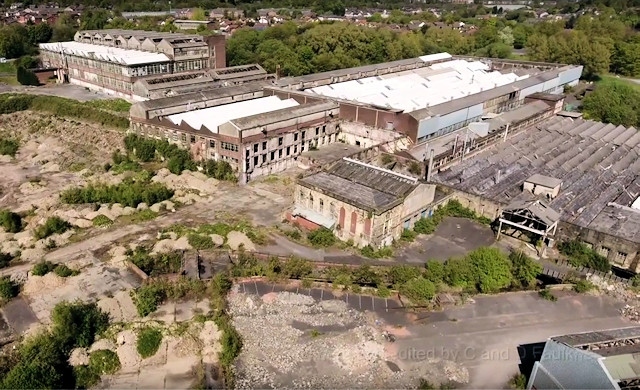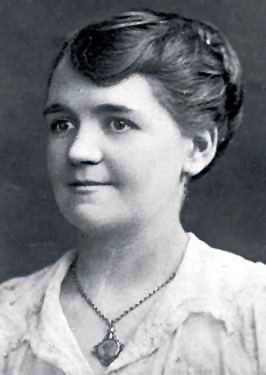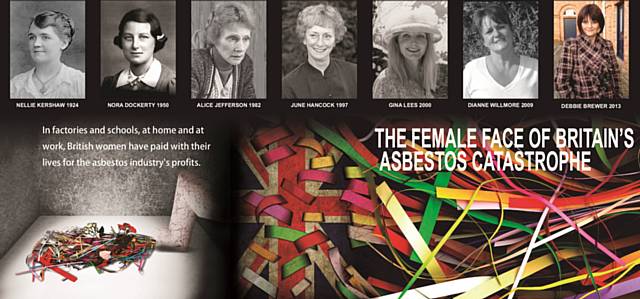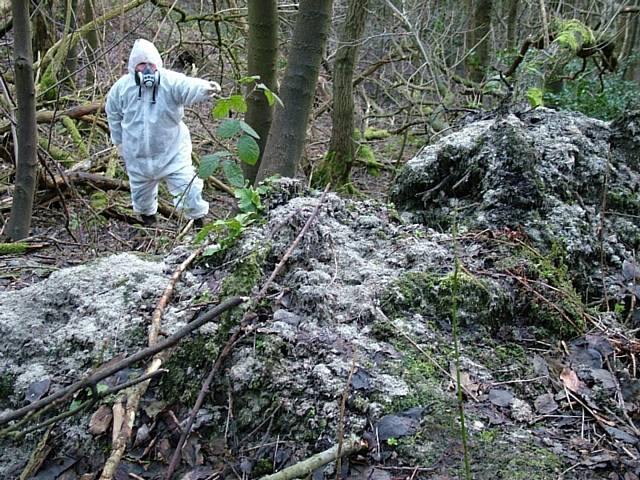The secret of Spodden Valley
Date published: 17 December 2018

Photo: Carl Faulkner
The former Turner Brothers Asbestos factory in Spodden Valley
Scroll down for Video
Hidden within the picturesque Spodden Valley, is the home of the world’s former largest asbestos factory, now a time-ravaged wreck shrouded in controversy and mystery.
Founded in 1871 as Turner Brothers, the plant initially manufactured cotton cloth-based packaging. In 1879, the company became the first in the UK to weave asbestos cloth and fittingly changed their name to Turner Brothers Asbestos Company.
At the height of production, the works employed 2,000 workers and 2,000 administrators. In 1920, the business was renamed Turner & Newall, after merging with the Washington Chemical Company, Newalls Insulation Company and J.W. Roberts.

Four years later, the factory was the scene of the UK’s first recorded death due to asbestos exposure. Local textile worker, Nellie Kershaw, died at the age of 33 from pulmonary asbestosis, a chronic disease that inflames and scars lung tissue.
A former cotton mill worker since she was 12, Nellie transferred to Turner Brothers in 1917, spinning raw asbestos fibres into yarn until 1922, when she became too sick to work. She was issued with a National Health Insurance certificate of ill health, naming her condition as ‘asbestos poisoning.’
As asbestos poisoning was not a recognised occupational disease, Nellie failed to qualify for any benefits. Her employer refused to assist with financial contributions, leaving Nellie to die in poverty.
Turners also refused to accept liability for her illness, paid no compensation to her family and refused to help with funeral expenses.
Following the inquest, Nellie’s death certificate gives her cause of death as ‘fibrosis of the lungs due to the inhalation of mineral particles.’
Three years after Nellie’s death, a more detailed report of her case in the British Medical Journal gave her illness the name recognised today: pulmonary asbestosis.
The first successful British asbestos claimant, Nora Dockerty (nee Kelly), also worked at Turner Brothers Asbestos.
Nora, a machine assistant in the carding and spinning department, had worked at the factory for 13 years when her contract of employment was terminated due to illness in November 1948.
After her death in 1950, aged just 31, Nora’s father, Mr Kelly, was left to pursue the company for compensation, as her husband had died sometime before her.
An autopsy enabled the coroner to confirm Nora’s cause of death as ‘generalised tuberculosis accelerated by the presence of asbestosis.’ A subsequent report by a Manchester medical panel concluded the cause of death as ‘Pneumoconiosis (Asbestosis) accompanied by tuberculosis.’
Mr Kelly then began a long legal battle; the case finally being settled in January 1952 with Turner and Newall paying £375 with costs.

In 2013, both women featured in a Westminster art feature by Colombian artist Guillermo Villamizar, alongside three more women with connections to Rochdale: Nancy Tait, an asbestos campaigner who visited the factory several times in the 1970s and 80s, Alice Jefferson, the focal point for a 1982 Yorkshire TV documentary that highly criticised the senior management of Turner and Newall, and June Hancock, the first asbestos cancer victim to successfully sue Turner and Newall for environmental asbestos exposure.
Since then, asbestos has unsurprisingly been linked to ‘in excess of 2,000 deaths’ from mesothelioma or asbestos-related lung cancer each year in the UK, according to the Health and Safety Executive. Symptoms take many years, even decades, to appear after originally being exposed to the microscopic fibres.

The Turner and Newall business was acquired by Federal-Mogul in 1998, before going into administration in 2001.
The site was then sold to MMC Estates, who submitted plans in December 2004 to build over 600 homes and a children’s nursery. The application summary claimed – despite visible asbestos hanging like cobwebs in the valley – ‘…of particular note is the absence of any asbestos contamination.’
In November 2004, amosite (‘brown asbestos’) was discovered in exposed tree roots within 10 metres of a footpath, cycle path and bridleway, the nearest houses less than 250 metres from the exposed fibres.
A year later, consultants Atkins Global were given the task of reporting on the environmental and site assessments that accompanied the controversial planning application by Rochdale Borough Council.
These plans were scrapped in 2010 after a determined community effort.
Soil tests on the TBA site in 2013 confirmed asbestos contamination in most of the test holes dug and United Utilities asbestos air testing detected elevated levels of asbestos fibres in the air.
According to the UK Land Registry for land title GM647719, ownership of the former TBA site lies with a mysterious offshore company based in a tax haven.
Renshaw Properties Ltd, based in the British Virgin Islands, took over legal ownership of the site in 2011: prior holders of the freehold were Hawksford Jersey Ltd (formerly known as Rathbone Jersey Ltd) which acquired the controversial former asbestos factory site in 2004.

In 2013, a blazing fire tore through the buildings, engulfing all the floors of the three-storey construction. Firefighters spent hours battling to bring the suspected arson under control. Some of the buildings were demolished later that year.
Twelve months later, the 72-acre site was hit by another fire causing extensive damage to the derelict buildings.
In recent years, concerns of fly-tipping and trespassers have repeatedly been raised, with very little else forthcoming about the site.
According to Rochdale Borough Council, the land owner’s representatives have removed fly-tipped material from the public pathways and improved site security.


In September 2016, representatives of the owners held a public meeting at Spotland Methodist Church after plans for a ground quality investigation were made public.
The geophysical ground survey was carried out between November 2016 and March 2017, with the findings still yet to be published.
The land owner’s representatives have confirmed that they have received the survey report from their contractor: despite the representatives stating they intend to share the report with the council, the council has not yet been provided with the report nor a timeframe.
Nicola Rogers, head of public protection at Rochdale Borough Council, said: “Rochdale Council is currently awaiting the survey report for the site.
“We will continue to work with the site owner’s representatives around the safety of the site and to address any concerns residents may have.”
Rochdale Borough Council has also confirmed that although it does not own the Turner Brothers site, it will support the owners to find a long-term solution and consider any proposal for remediation proposed, determining its suitability through the planning process.

A £26,000 council-commissioned air survey in October 2017 identified the discovery of only one asbestos fibre containing amphibole (‘brown’ or ‘blue’ asbestos) from a sample taken at Harridge Avenue.
Amphibole asbestos consists of straight, thin, needle-like fibres that are not as flexible as chrysotile ('white'), a 'curly' form of the mineral, which is also the most common variety. The TBA factory primarily processed white asbestos, although previous investigations had identified both brown and blue asbestos in areas of the site.
Testing took place at various locations around the site on a monthly basis, taking 103 samples between August 2015 to March 2017, split into in two phases using two different types of analysis.

With the legacy of the site having such an impact on people’s lives, hundreds of local residents concerned about asbestos contamination and damage to wildlife habitat formed the Save Spodden Valley campaign in 2004, working to secure a safe future for what was once the world's largest asbestos textile factory, calling for open, safe and transparent decision making.
A Spodden Valley spokesperson commented: "It has been two years since the mysterious ‘TBA Project Team’ published a glossy brochure and organised a ‘drop-in’ Q&A session.
“This was public money used to promote the interests of an anonymous private company incorporated in a Caribbean tax haven.
"In fairness, many council officers have tried their best to answer questions about the site and contamination.
“Frustration may be levelled at the possibility of questionable decisions made about 15 years ago – well before the time many of today's officers were in current posts.
"The former TBA asbestos site in the Spodden Valley is recognised to be of international significance and has been highlighted regularly at Parliament.”
The spokesperson concluded: "It is essential that all the facts about asbestos and contamination are fully disclosed so that safe and accountable decisions can be made: the people of Rochdale deserve no less."
Read more:
There are over 250 articles dating back to 2005 relating to the former asbestos factory site and the Save Spodden Valley campaign in the Rochdale Online news archives:
Drone footage of the former Turner Brothers Asbestos site
©Carl Faulkner
Do you have a story for us?
Let us know by emailing news@rochdaleonline.co.uk
All contact will be treated in confidence.
Most Viewed News Stories
- 1Winners of the 2024 Rochdale Diversity Awards
- 2Flag of Palestine raised in Rochdale to mark international solidarity event
- 3Off-road bike crackdown on Rochdale moorlands sees success
- 4Severely dyslexic Rochdale author overcomes major challenges to publish his first novel
- 5Riverside brings Christmas magic with markets, Santa’s Grotto and more
To contact the Rochdale Online news desk, email news@rochdaleonline.co.uk or visit our news submission page.
To get the latest news on your desktop or mobile, follow Rochdale Online on Twitter and Facebook.


